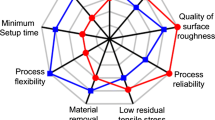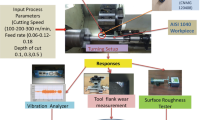Abstract
Purpose
The demand for hardened steel for different applications particularly in the field of aviation and the automotive industry is increasing day by day. Different machining procedures like grinding, electric discharge were utilized for the machining steel. These machining measures are tedious because of the lesser material evacuation rate and an impediment to cutting complex profiles. The new emerging advanced process, hard turning, has the potential to produce parts from the hardened steel using single-point advanced cutting tools like ceramics, cubic boron nitride, and carbide. The cutting tool is exposed to large mechanical and high-temperature loads as a result, vibrations are generated throughout the machining process consequently the event of rapid wear and catastrophic failure of the cutting edge. As a result, the ability to estimate tool wear for hard turning is critical.
Objective
This paper aims to evaluate tool vibration acceleration with varying machining parameters such as cutting speed, feed, and depth of cut to create a predictive mathematical model and tool condition monitoring system (TCMS).
Methods
The Central Composite Rotatable Design approach is used to conduct the trials. The experimental results are examined, and regression analysis is utilized to create a mathematical model. The model is being used to create a tool monitoring system based on a microcontroller. The prediction model is compared to the proposed system, and the results are presented.
Results
After analyzing the data, it was revealed that the cutting conditions and vibration signals have a significant effect on tool wear. The DataFit Statistical commercial tool is used to do statistical analysis on the gathered results. DataFit Statistical commercial tool. The tool wear model's R2 value is 0.93, indicating that the factors cutting speed, feed, and depth of cut, as well as accelerations Vx, Vy, and Vz, have a considerable impact on tool wear and offer reliable flank wear estimations. The residuals are close to a straight line with a maximum error of 9%, indicating that error is normally distributed and the model does not suggest any insufficiency and gives a trustworthy prediction, according to the normal probability plot. It is seen that tool wear obtained from developed TCMS has the maximum percentage error of 12.24% with experimental value and minimum error is 7.62%, whereas the maximum and minimum error of RA model with TWMS results is 12.37% and 1.04%, respectively.












Similar content being viewed by others
References
Kasim NA, Nuawi MZ, Ghani JA, Rizal M, Ahmad MAF, Che Haron CH (2019) Cutting tool wear progression index via signal element variance. J Mech Eng Sci 13(1):4596–4612
Huang Y, Liang SY (2010) Modeling of cutting forces under hard turning conditions considering tool wear effect. Trans ASME 262(127):262–270
Teti R, Jemielniak K, O’Donnell G, Dornfeld D (2010) Advanced monitoring of machining operations. CIRP Ann Manuf Technol 79:717–739
Bhuiyan MSH, Choudhury IA (2015) Investigation of tool wear and surface finish by analyzing vibration signals in turning Assab-705 steel. Mach Sci Technol 19(2):236–261
Zhiwen H, Jianmin Z, Lei J, Li X, Tian F (2021) Tool wear monitoring with vibration signals based on short-time Fourier transform and deep convolutional neural network in milling. Math Probl Eng 2021:1–10
Elangovan M, Sugumaran V, Ramachandran KI, Ravikumar S (2011) Effect of SVM kernel functions on classification of vibration signals of a single point cutting tool. Expert Syst Appl 38:15202–15207
Aliustaoglu C, Ertunc HM, Ocak H (2009) Tool wear condition monitoring using a sensor fusion model based on fuzzy inference system. Mech Syst Signal Process 23:539–546
Dimla DE Sr, Lister PM (2000) On-line metal cutting tool condition monitoring II: tool-state classification using multi-layer perceptron neural networks. Int J Mach Tools Manuf 40:769–781
Dimla DE Sr (2004) The impact of cutting conditions on cutting forces and vibration signals in turning with plane face geometry inserts. J Mater Process Technol 155:1708–1715
Prasad BS, Babu MP (2017) Correlation between vibration amplitude and tool wear in turning: numerical and experimental analysis. Eng Sci Technol Int J 20:197–211
Rao KV, Murthy BSN, Rao NM (2013) Cutting tool condition monitoring by analyzing surface roughness, work piece vibration and volume of metal removed for AISI 1040 steel in boring. Measurement 46:4075–4084
Abdollah M, Martinez D, Obrien EJ (2018) The feasibility of using laser Doppler vibrometer measurements from a passing vehicle for bridge damage detection. Shock Vib 2018:1–10
Ghasempoor A, Jeswiet J, Moore TN (1999) Real time implementation of on-line tool condition monitoring in turning. Int J Mach Tools Manuf 39:1883–1902
Scheffer C, Kratz H, Heyns PS, Klocke F (2003) Development of a tool wear-monitoring system for hard turning. Int J Mach Tools Manuf 43:973–985
Abouelatta OB, Madl J (2001) Surface roughness prediction based on cutting parameter and tool vibration in turning operation. J Mater Process Technol 118:269–277
Zhang JZ, Chen JC (2008) Tool condition monitoring in an end-milling operation based on the vibration signal collected through a microcontroller-based data acquisition system. Int J Adv Manuf Technol 39:118–128
Zhang XY, Lu X, Wang S, Wang W, Li W (2018) A multi-sensor based online tool condition monitoring system for milling process. Procedia CIRP 72:1136–1141
Goyal D, Pabla BS (2016) Development of non-contact structural health monitoring system for machine tools. J Appl Res Technol 14:245–258
Barton D, Gonnheimer P, Schade F, Ehrmann C, Becker J, Fleischer J (2019) Modular smart controller for Industry 4.0 functions in machine tools. Procedia CIRP 81:1331–1336
Saponara S, Fanucci L, Bernardo F, Falciani A (2015) A network of vibration measuring nodes with integrated signal processing for predictive maintenance of high power transformers. In: IEEE 9th International symposium on intelligent signal processing, pp 1–4
Elnady ME, Sinha JK, Oyadiji SO (2012) Condition monitoring of rotating machines using on-shaft vibration measurement. In: 10th International conference on vibrations in rotating machinery, institution of mechanical engineers, pp 669–678
Albarbar A, Mekid S, Starr A, Pietruszkiewicz R (2008) Suitability of MEMS accelerometers for condition monitoring: an experimental study. Sensors 8:784–799
Ambhore N, Kamble D, Chinchanikar S (2019) Evaluation of cutting tool vibration and surface roughness in hard turning of AISI 52100 steel: an experimental and ANN approach. J Vib Eng Technol 8:455–462
Montgomery DC (2004) Design and analysis of experiments, 6th edn. Wiley, India
Oehlert GW (2000) A first course in design and analysis of experiments
Author information
Authors and Affiliations
Corresponding author
Ethics declarations
Conflict of interest
On behalf of all authors, the corresponding author states that there is no conflict of interest.
Additional information
Publisher's Note
Springer Nature remains neutral with regard to jurisdictional claims in published maps and institutional affiliations.
Rights and permissions
About this article
Cite this article
Ambhore, N., Kamble, D. & Agrawal, D. Experimental Investigation of Induced Tool Vibration in Turning of Hardened AISI52100 Steel. J. Vib. Eng. Technol. 10, 1679–1689 (2022). https://doi.org/10.1007/s42417-022-00473-4
Received:
Revised:
Accepted:
Published:
Issue Date:
DOI: https://doi.org/10.1007/s42417-022-00473-4




